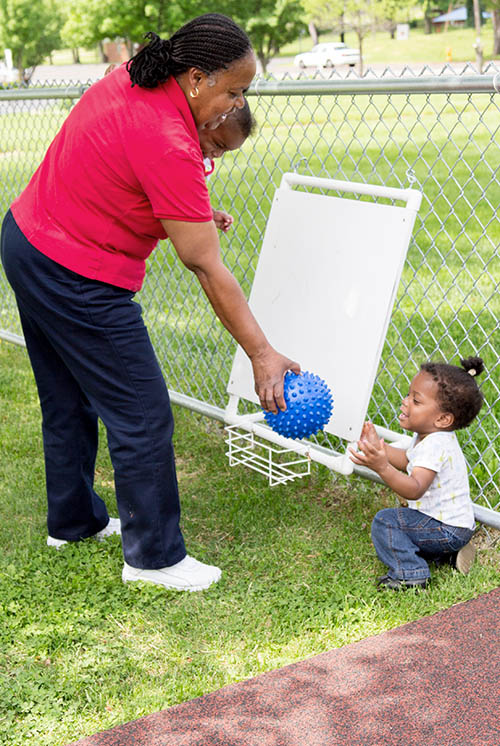When creating annual professional development plans, make outdoor play and learning a priority. Provide workshops, presentations, and other resources that focus on topics such as:
- Benefits of outdoor play for infants and toddlers

- Creating safe outdoor play spaces
- Planning safe and stimulating outdoor play experiences
- Adapting outdoor play and exploration experiences for children with physical, cognitive, and sensory disabilities
- Addressing staff and family concerns about spending time outdoors with children
Pre- and in-service trainings, staff meetings, parent meetings and trainings, home visits, and group socialization events are ideal times to talk about outdoor play and exploration.
When planning for professional development opportunities, consider addressing the following aspects of preparing for and implementing outdoor experiences.
- Staff and families can use the same thoughtful and intentional strategies for engaging with infants and toddlers outdoors as they use indoors. These strategies not only strengthen adult-child relationships but also help infants and toddlers engage with the outdoor environment:1
- Follow children's leads and adapt plans to take advantage of unexpected discoveries
- Provide physical and emotional support
- Describe what children see and do (e.g., label objects, actions, and feelings) and ask open-ended questions
- Smile, laugh, and show delight in being outside with children
- Some staff and families find it time consuming or frustrating to take infants and toddlers outside when the weather requires coats, hats, snowsuits, boots, and mittens. However, getting dressed is an important routine and part of infant and toddler curriculum. Dressing offers young children a language-rich, social and emotional, and self-care learning experience; it is not just a routine to get through quickly on the way to going outside.3 Encourage staff and families to plan and organize ahead of time to make sure they allow enough time for dressing children in outerwear, spending quality time outdoors, undressing indoors, and transitioning to the next daily experience or routine.4 When the group includes infants or toddlers with suspected delays and identified disabilities, it is especially important to make sure there is adequate time for these routines and transitions so they don't miss planned time outdoors.
- Not all outdoor experiences have to take place within designated outdoor play spaces. If safe to do so, staff and families can take infants and toddlers on neighborhood buggy rides and walks. These outings expose children to new things to see, hear, touch, and smell, and they help children learn about their communities. Emphasize that a successful outing for infants and toddlers is much less about getting to a destination or the distance traveled and much more about slowly exploring every crack, bug, and wall along the way. When possible, encourage staff and families to plan outings that include time and places where children can be out and moving, especially if they are being transported in strollers, buggies, and wagons.4 Ideally, plan walks and rides in addition to outdoor time in a safe, outdoor play space.5 Infants and toddlers benefit from both types of experiences. Make sure staff follow policies and procedures for active supervision and pedestrian safety when taking children on walks and rides.
- Staff and families may wonder how much time infants and toddlers should spend outside. Programs typically determine this based on factors such as children's age, length of program day or group socialization event, weather and other safety conditions, or a family's daily schedule. CFOC 3.1.3.1: Active Opportunities for Physical Activity suggests the following for center-based and family child care programs; home-based programs may also consider how these guidelines might apply in their daily schedules. Note that the amount of time infants and toddlers spend outside may exceed these recommendations.
- All children, from birth to 6 years old, should participate daily in two to three occasions of active outdoor play, weather permitting.
- Infants (birth to 12 months) should be taken outside two to three times per day, as they can tolerate. There is no recommended length of time for these outdoor play experiences.
- Toddlers (12 to 35 months) should be allowed 60 to 90 total minutes of outdoor play. These times can be shortened during adverse weather conditions in which children may still play safely outdoors for shorter periods. However, the amount of active indoor time should increase so the total amount of active play (exercise) remains the same.
The American Academy of Pediatrics says that, since most sun damage occurs in childhood, it is best to limit sun exposure during peak intensity hours—between 10 a.m. and 4 p.m.6 Keep this in mind when determining outdoor play schedules.
- Preparing for outdoor experiences should include allotting time for ongoing child assessment. As noted previously, outdoor experiences support children's learning and development in all domains of the ELOF. This means there are opportunities to observe and document what children know and can do. Outdoor experiences are an especially good time to assess children's gross motor skills and safe behaviors. Children will also demonstrate language, communication, cognitive, approaches to learning, and social and emotional skills.
1Post et al., Tender Care and Early Learning, 343, 367.
2Trister Dodge et al., The Creative Curriculum, 189.
3Williams, "Exploring the Natural World," 21.
4Greenman et al., Prime Times, 298.
5Post et al., Tender Care and Early Learning, 249–250.
6American Academy of Pediatrics, "Sun Safety and Protection Tips."
Read more:
Resource Type: Article
National Centers: Early Childhood Development, Teaching and Learning
Last Updated: December 9, 2019
